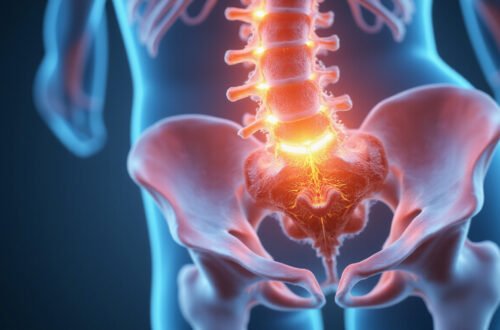Sciatica diagnosis is a crucial first step toward relieving the intense nerve pain that affects millions worldwide. Sciatica, characterized by sharp, shooting pain radiating along the sciatic nerve from the lower back down through the legs, can severely impact daily life. Understanding how specialists diagnose this condition helps ensure timely and effective treatment, improving quality of life and preventing chronic complications. In this article, we’ll explore the key steps involved in sciatica diagnosis and discuss practical approaches for managing this nerve pain effectively.
Understanding Sciatica and Its Symptoms
Before diving into the diagnosis steps, it’s essential to understand what sciatica involves. Sciatica occurs when the sciatic nerve—running from the lumbar spine through the hips and buttocks down each leg—becomes compressed or irritated. This nerve impingement can result from a variety of causes, including herniated discs, spinal stenosis, or piriformis syndrome.
Common symptoms of sciatica include:
- Sharp or burning pain radiating from the lower back to the thigh and calf
- Numbness or tingling in the leg or foot
- Muscle weakness in the affected leg
- Difficulty moving or controlling the leg due to pain
Early recognition of these symptoms is vital, making sciatica diagnosis a necessary step to differentiate it from other forms of lower back pain.
Step 1: Detailed Medical History
The first and most fundamental step in sciatica diagnosis is collecting a detailed medical history. Physicians ask about symptom onset, duration, intensity, and pain triggers. Questions may include:
- When did the pain start?
- Did the pain begin suddenly or gradually?
- Which activities or positions worsen or relieve the pain?
- Are there any accompanying symptoms like numbness or weakness?
- Does anyone in your family have a history of spinal issues?
Understanding the patient’s lifestyle, injury history, and other medical conditions allows the healthcare provider to narrow down potential causes of the sciatic nerve pain.
Step 2: Physical and Neurological Examination
Conducting a hands-on physical exam helps doctors evaluate sciatica symptoms and identify nerve involvement. This typically involves:
- Checking posture and spinal alignment
- Testing range of motion in the hips and lower back
- Assessing muscle strength and reflexes in the legs
- Performing specific maneuvers to reproduce sciatic pain
One common test is the Straight Leg Raise (SLR) test. During this test, the leg is lifted while keeping the knee straight. If lifting the leg between 30-70 degrees produces sciatic pain radiating down the leg, it suggests nerve root irritation.
Neurological exams test sensations and motor function to understand if the nerve compression leads to weakness or sensory changes. These detailed assessments contribute significantly to sciatica diagnosis.

Step 3: Imaging Tests for Confirmation
In many cases, physical examination alone isn’t enough for an accurate sciatica diagnosis. Imaging tests provide visual confirmation of the underlying problem. Common imaging techniques include:
-
Magnetic Resonance Imaging (MRI): This is the most frequently used imaging tool as it can provide detailed images of soft tissues, including intervertebral discs and nerve roots. MRI helps identify herniated discs, spinal stenosis, or tumors pressing on the sciatic nerve.
-
Computed Tomography (CT) Scan: Sometimes utilized when MRI is unavailable or contraindicated, CT scans give detailed bone images to detect spinal abnormalities.
-
X-rays: While limited to showing bone structure, X-rays can help rule out fractures, tumors, or alignment issues.
Imaging solidifies the diagnosis by pinpointing the exact cause of nerve compression causing sciatica symptoms.
Step 4: Electromyography (EMG) and Nerve Conduction Studies
If diagnosis remains unclear or symptoms are severe, doctors may request electromyography (EMG) and nerve conduction studies. These tests measure electrical activity in muscles and nerve signals to determine if nerves are functioning correctly.
EMG can detect nerve root compression, confirm sciatica, and distinguish it from other conditions like peripheral neuropathy. This step is especially valuable when symptoms persist despite normal imaging results.
Treatment Options After Sciatica Diagnosis
Once a definitive sciatica diagnosis is made, treatment depends on the severity and underlying cause. Here are common approaches:
1. Conservative Treatments
- Physical Therapy: Tailored exercises can relieve nerve pressure, improve flexibility, and strengthen supporting muscles.
- Pain Management: Over-the-counter medications like NSAIDs (ibuprofen) or prescribed muscle relaxants may ease pain and inflammation.
- Heat and Ice Therapy: Applying heat increases blood flow, while ice reduces inflammation, helping to manage acute pain episodes.
- Lifestyle Changes: Avoiding heavy lifting, prolonged sitting, and practicing good posture can reduce nerve irritation.
2. Interventional Procedures
- Epidural Steroid Injections: Corticosteroids injected near nerve roots help reduce inflammation and pain for severe cases.
- Nerve Blocks: Temporary nerve desensitization can provide pain relief.
3. Surgical Intervention
Surgery is typically considered if sciatica causes significant disability or if conservative treatments fail after 6–12 weeks. Common procedures include discectomy or laminectomy, which relieve pressure on the nerve by removing problematic tissue.
Important Lifestyle Tips to Complement Treatment
In addition to medical treatment based on sciatica diagnosis, certain lifestyle adjustments can accelerate recovery and prevent recurrence:
- Maintain a healthy weight to reduce spinal stress
- Incorporate regular low-impact exercise such as walking or swimming
- Use ergonomic chairs and mattresses to support spinal health
- Avoid smoking, as it impairs blood circulation to spinal tissues
These changes support spine health and nerve function over the long term.
Quick Reference: Key Steps in Sciatica Diagnosis
- Detailed medical history assessment
- Physical and neurological examination including the Straight Leg Raise test
- Imaging studies such as MRI or CT scans
- Electromyography (EMG) and nerve conduction studies when needed
- Development of a personalized treatment plan based on findings
Frequently Asked Questions About Sciatica Diagnosis
Q1: How soon should I seek medical evaluation for suspected sciatica?
A: If you experience persistent leg pain, numbness, or weakness lasting over a few days, you should consult a healthcare provider promptly for an accurate sciatica diagnosis and treatment.
Q2: Can sciatica diagnosis be made without MRI?
A: While doctors can often identify sciatica through history and physical exams, MRI provides critical confirmation, especially to determine the exact cause of nerve compression.
Q3: Is sciatica diagnosis a long process?
A: The initial sciatica diagnosis can occur quickly through exam and history, but comprehensive evaluation including imaging and nerve tests may take days to weeks depending on severity and complexity.
For anyone struggling with nerve pain, obtaining a timely sciatica diagnosis allows for targeted, effective treatment. According to the American Academy of Orthopaedic Surgeons, early diagnosis combined with appropriate management reduces the risk of chronic pain and disability (source).
Conclusion: Take Control of Your Sciatic Nerve Pain Today
If you suspect you have sciatic nerve pain, don’t delay seeking a professional sciatica diagnosis. Early identification of the cause allows you to pursue treatments tailored to your condition—whether physical therapy, medication, or in some cases, surgery. Managing sciatica effectively improves mobility, reduces pain, and enhances overall quality of life. Schedule an appointment with a spine specialist or neurologist to start your journey toward relief and regain control over your health. Remember, proper diagnosis is the key to successful treatment. Don’t let sciatica pain dictate your day—take the essential steps today!





